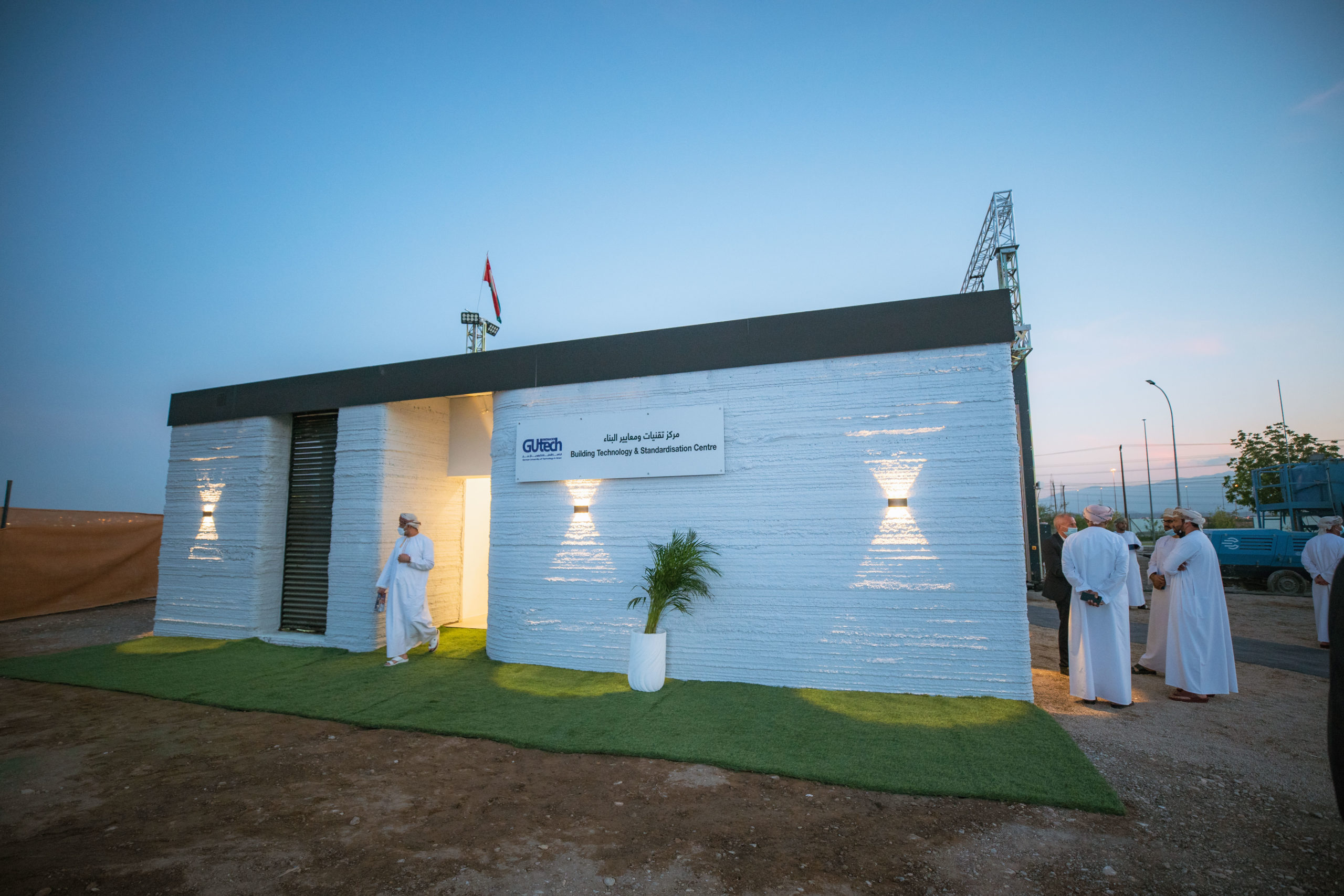In light of economic pressure, global resources shortages, and looming climate goals, the world is seeking cost-effective, fast, and environmentally friendly approaches to long-held practices and processes—the construction sector being one notable example. Sustainability innovations that both reduce carbon emissions and enhance productivity have been gaining traction in the industry, and in recent years, we’ve seen how trailblazing companies have revolutionized construction by using 3D printers (3DP).

The 3DP sector is set to grow at a staggering 101% yearly rate until 2030, meaning we’ve only seen the beginning of what the industry will achieve in the next few years. Projects like COBOD and GUtech’s record-breaking 3DP houses in Oman, in which three houses were built in eight days, have impressed the world with the possibilities in store for additive construction.
Time-saving and cost-effective construction strategies are in high demand, but what will additive construction surprise us with next year? Let’s explore some 3DP trends that we can expect to see in 2023.
Development of More Efficient Material Mixes
One of the main issues in 3DP is the specific variety of malleable cement that machines require, as traditional materials aren’t as flexible. Likewise, not all mixes strive for carbon neutrality. Global carbon dioxide (CO2) emissions from cement rose in 2022, which desperately calls for the construction sector to adopt more flexible and sustainable materials once and for all.
One such example of the different companies manufacturing new efficient material mixes with the aim to lower carbon emissions is COBOD. The startup recently partnered with building materials manufacturer, CEMEX, to develop D.fab, an easily applicable and cost-effective 3DP material solution that has already been applied to some of the startup’s most recent projects around the world. Furthermore, new solutions like D.fab that allow suppliers to source most of the materials locally lead to numerous cost savings.
Moving away from traditional, high carbon emitting cementious products and towards new alternatives will dramatically reduce the industry’s carbon footprint. Using industrial byproducts for manufacturing mixes will also help feed the circular economy. Fly ash, slag, and other cementitious components will become materials of choice for future 3D printed concrete. As new environmentally friendly mixtures make their way into 3D printed cement, the next challenge is the wide-spread adoption of these materials to 3DP mixes to increase the efficiency of the growing industry.

A much bigger glimpse into the future of 3D printing mixtures is NASA’s LINA structure, which will be a 3D-printed installation on the moon using lunar regolith (lunar soil) and other earth-sourced polymers. We are hopeful to see advancements to existing 3DP material mixes, as well as new alternatives in the near future.
Large-scale Structures and Modularity
When it comes to additive construction, we tend to hear a lot about single-family houses and small units, but let’s think ambitiously. What about large-scale, multiple-story structures? The cost-efficiency and advantages of 3D printed can also be applied to multi-unit buildings.
Just earlier this last year, COBOD, PERI, and RUPP collaborated to build a five-unit, three-story residential building in Wallenhausen, Germany. COBOD employed their BOD2 printer with seven modules around the base, creating a 380 square meter living space that already hosts inhabitants today. The building’s rent is similar to traditional homes around the neighborhood—meaning that prices didn’t rise due to the building’s 3D-printed infrastructure.
Another win for bigger structures, is Kamp C’s two-story house in Belgium. The company used the largest 3D printer in Europe to assemble the one-piece, 90-square-meter house in just three weeks. Recent projects indicate that the industry is expanding its horizons and veering towards larger-scale buildings that suit the rising housing needs around the world.
Outside of Europe the largest 3D printed building project in the US is currently underway. The 4,000 square foot, two story 3D printed house by PERI and CIVE in Houston, Texas showcases the possibilities of 3D printing technology, mass customization, and design solutions that integrate conventional construction methods. We should expect to see more of these projects in 2023.

On this topic, we should also talk about modular printing. This increasingly popular construction technique brings time-saving possibilities to the industry, as parts can be quickly manufactured off-site and transported to each location. Modular homes are 15% cheaper to build and energy-efficient thanks to their insulating capabilities. Additionally, as manufacturers only make the exact number of parts they need, there’s barely any waste involved in the building process. This lowers costs and improves sustainability and return on investment. Ergo, applying 3DP technology to modular homes will only increase these benefits.
The global affordable housing crisis is affecting how people build and purchase homes. The next challenge for modular printing is expanding upwards rather than sideways by building multi-story structures that yield the same cost-effective benefits as single-story 3D printed homes.
Improvement of Building Codes
In 2021, the International Residential Code (IRC) introduced an appendix for 3DP, laying the groundwork for the industry’s building codes. Every project must be approved by the safety agency UL Solutions and comply with a small set of design rules. This is a great starting point, but as more 3DP projects take place next year, these novel regulations will become integrated and more commonplace within the industry.
In the past, issue permits for 3DP structures took a long time to receive since not all construction authorities and officials because of the scarcity of 3DP assignments and the technology. This means visionary projects still hit walls that stall the industry’s progress. The prediction in 2023 is that the limited reference to 3DP in the 2021 IRC appendix will expand and include more specific regulations that don’t leave authorities and manufacturers in confusing and inefficient grey zones.
With 2022 being a seminal year for robust and realistic 3DP structures, 2023 will bring these housing projects closer to the mainstream. Expanding regulations, flexible and sustainable cement mixes, and larger-scale buildings will help mitigate the global housing crisis. The traditional construction sphere should invest in these new efforts to improve production times and bring their operations closer to the industry’s future.
About the Author
Ibon Iribar, Investment & Open Innovation Advisor at CEMEX Ventures, deeply explores and analyses advanced technologies for the construction industry and helps identify investment and business development opportunities with new startups, projects, and entities of the construction technology ecosystem across multiple markets. Ibon leads the efforts for the biggest challenge for construction startups, Construction Startup Competition, and works year-round seeking the most innovative and promising solutions to invest in or collaborate with, supporting startups´ development and their growth within the built environment.
Subscribe to Our Email Newsletter
Stay up-to-date on all the latest news from the 3D printing industry and receive information and offers from third party vendors.
Print Services
Upload your 3D Models and get them printed quickly and efficiently.
You May Also Like
3D Printing News Briefs, July 2, 2025: Copper Alloys, Defense Manufacturing, & More
We’re starting off with metals in today’s 3D Printing News Briefs, as Farsoon has unveiled a large-scale AM solution for copper alloys, and Meltio used its wire-laser metal solution to...
3DPOD 260: John Hart on VulcanForms, MIT, Desktop Metal and More
John Hart is a Professor at MIT; he´s also the director of the Laboratory for Manufacturing and Productivity as well as the director of the Center for Advanced Production Technologies....
3D Printing News Briefs, June 28, 2025: Defense Accelerator, Surgical Models, & More
In this weekend’s 3D Printing News Briefs, 3YOURMIND was selected to join an EU Defense Accelerator, and PTC has announced model-based definition (MBD) capabilities within Onshape. Finally, a study out...
EOS in India: AM’s Rising Star
EOS is doubling down on India. With a growing base of aerospace startups, new government policies, and a massive engineering workforce, India is quickly becoming one of the most important...

































